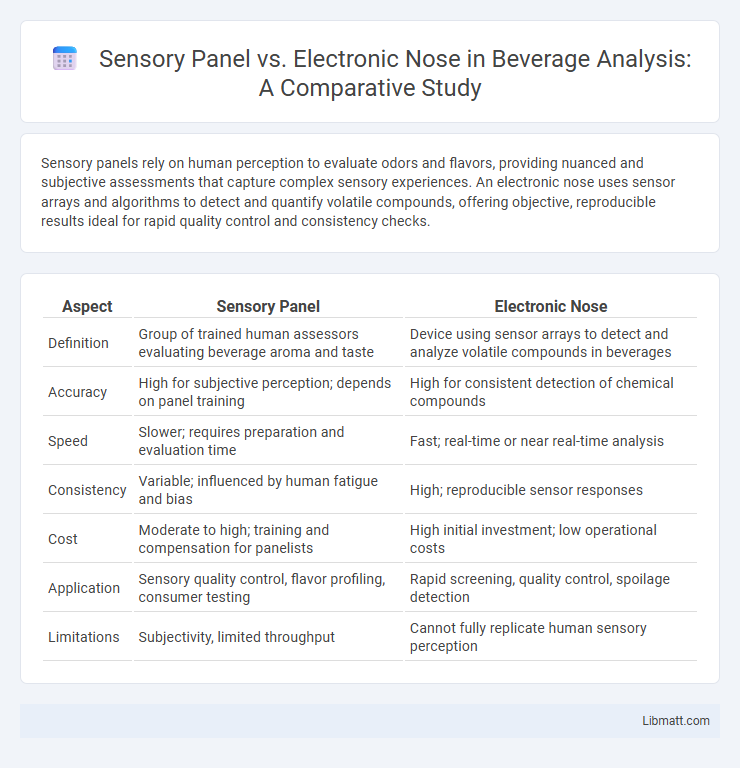Sensory panels rely on human perception to evaluate odors and flavors, providing nuanced and subjective assessments that capture complex sensory experiences. An electronic nose uses sensor arrays and algorithms to detect and quantify volatile compounds, offering objective, reproducible results ideal for rapid quality control and consistency checks.
Table of Comparison
| Aspect | Sensory Panel | Electronic Nose |
|---|---|---|
| Definition | Group of trained human assessors evaluating beverage aroma and taste | Device using sensor arrays to detect and analyze volatile compounds in beverages |
| Accuracy | High for subjective perception; depends on panel training | High for consistent detection of chemical compounds |
| Speed | Slower; requires preparation and evaluation time | Fast; real-time or near real-time analysis |
| Consistency | Variable; influenced by human fatigue and bias | High; reproducible sensor responses |
| Cost | Moderate to high; training and compensation for panelists | High initial investment; low operational costs |
| Application | Sensory quality control, flavor profiling, consumer testing | Rapid screening, quality control, spoilage detection |
| Limitations | Subjectivity, limited throughput | Cannot fully replicate human sensory perception |
Introduction to Sensory Panel and Electronic Nose
A sensory panel consists of trained human assessors who evaluate product attributes such as aroma, taste, and texture through direct perception, providing nuanced and subjective insights. An electronic nose uses sensor arrays and pattern recognition algorithms to detect and classify volatile compounds, offering rapid, objective, and reproducible odor analysis. Your choice between a sensory panel and an electronic nose depends on the need for human judgment versus automated precision in quality control or research applications.
Defining Sensory Panel Analysis
Sensory panel analysis involves human participants trained to evaluate and describe the flavor, aroma, and texture of products based on their sensory perceptions. This method provides nuanced, subjective insights that electronic noses, which use sensor arrays to detect chemical compounds, may not fully capture. Your choice between the two depends on whether detailed human sensory experience or rapid, objective chemical profiling is more critical for your application.
Understanding Electronic Nose Technology
Electronic nose technology employs sensor arrays that mimic human olfactory receptors to detect and analyze complex odors with high precision and reproducibility. Unlike a sensory panel relying on subjective human perception, electronic noses provide objective, quantifiable data by capturing volatile organic compounds (VOCs) in real-time. Your ability to assess aroma profiles or contamination improves significantly with electronic nose systems due to their rapid response and consistency across various applications.
Key Differences Between Sensory Panel and Electronic Nose
Sensory panels rely on human perception, using trained individuals to evaluate aroma and flavor nuances based on subjective experiences, whereas electronic noses utilize sensor arrays to detect and quantify volatile compounds objectively. Sensory panels provide insights into human sensory responses, including emotional and cultural factors, while electronic noses offer rapid, reproducible, and quantifiable data without sensory fatigue. Key differences center on subjectivity versus objectivity, emotional interpretation versus chemical detection, and variable human variability versus consistent sensor performance.
Advantages of Sensory Panel Evaluation
Sensory panel evaluation offers unparalleled human perception capabilities, capturing complex aromas and subtle flavor nuances that electronic noses may overlook or misinterpret. The adaptability and context-aware judgment of trained panelists provide holistic assessments, integrating tactile, olfactory, and gustatory inputs simultaneously. This method excels in qualitative evaluations critical for food, beverage, and fragrance industries where consumer preferences and emotional responses are essential.
Benefits of Using Electronic Nose Systems
Electronic nose systems provide objective, consistent, and rapid analysis of complex odor profiles, overcoming human sensory panel limitations such as fatigue and subjectivity. These devices enhance quality control processes in food, beverage, and environmental industries by delivering reproducible results and detecting volatile compounds at low concentrations. Integration with machine learning algorithms further improves their accuracy and enables automated monitoring of product quality and contamination.
Applications in Food and Beverage Industry
Sensory panels provide human-based evaluation of aroma, flavor, and texture, offering nuanced insights crucial for product development and quality control in the food and beverage industry. Electronic noses use sensor arrays and pattern recognition to rapidly detect and quantify volatile compounds, enabling objective and consistent monitoring of freshness, spoilage, and contamination. Your choice between these methods depends on whether you prioritize subjective sensory perception or precise chemical analysis for quality assurance.
Accuracy and Reliability: Human vs Machine
Sensory panels provide nuanced and context-rich assessments based on human perception, but their accuracy can be influenced by individual variability and fatigue. Electronic noses offer consistent and reproducible results through sensor arrays and advanced algorithms, minimizing subjective bias. Your choice depends on prioritizing the complex interpretative abilities of human senses or the objective precision and repeatability of machine analysis.
Cost and Efficiency Considerations
Sensory panels require trained human assessors, leading to higher ongoing costs and time-consuming evaluations, while electronic noses offer faster, automated analysis with lower operational expenses after initial investment. Your choice depends on balancing the accuracy and complexity of odor detection against budget constraints and throughput needs. Electronic noses provide efficiency in large-scale or repetitive testing, whereas sensory panels remain valuable for nuanced, subjective sensory evaluations.
Future Trends in Aroma and Flavor Analysis
Future trends in aroma and flavor analysis emphasize the integration of sensory panels with electronic nose technology to enhance accuracy and objectivity in product evaluation. Advanced machine learning algorithms enable electronic noses to identify complex volatile compounds with higher sensitivity, complementing human sensory data. These innovations drive improvements in quality control, product development, and consumer preference prediction across the food and beverage industry.
Sensory panel vs electronic nose Infographic

 libmatt.com
libmatt.com